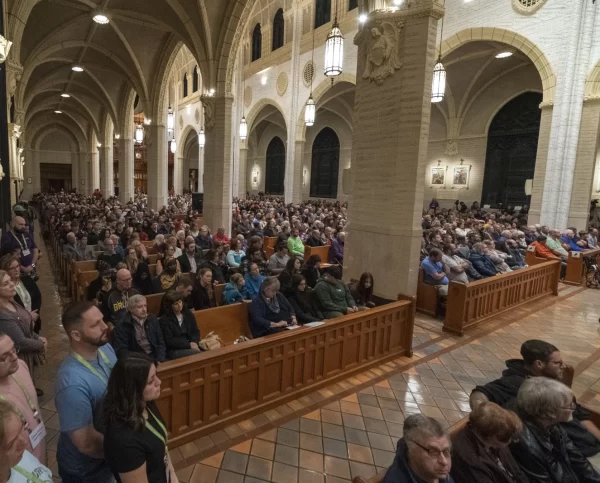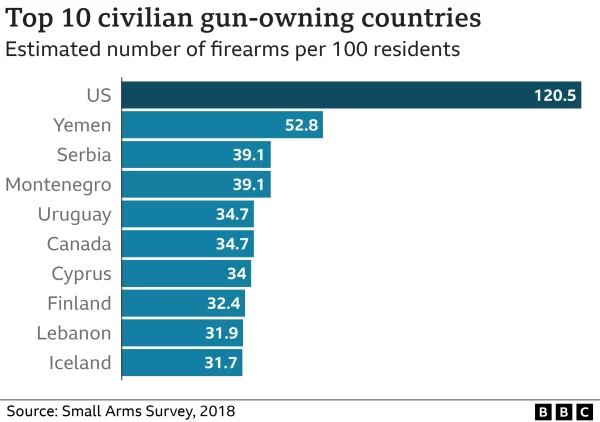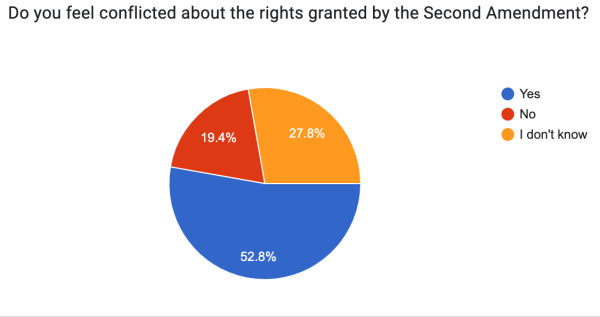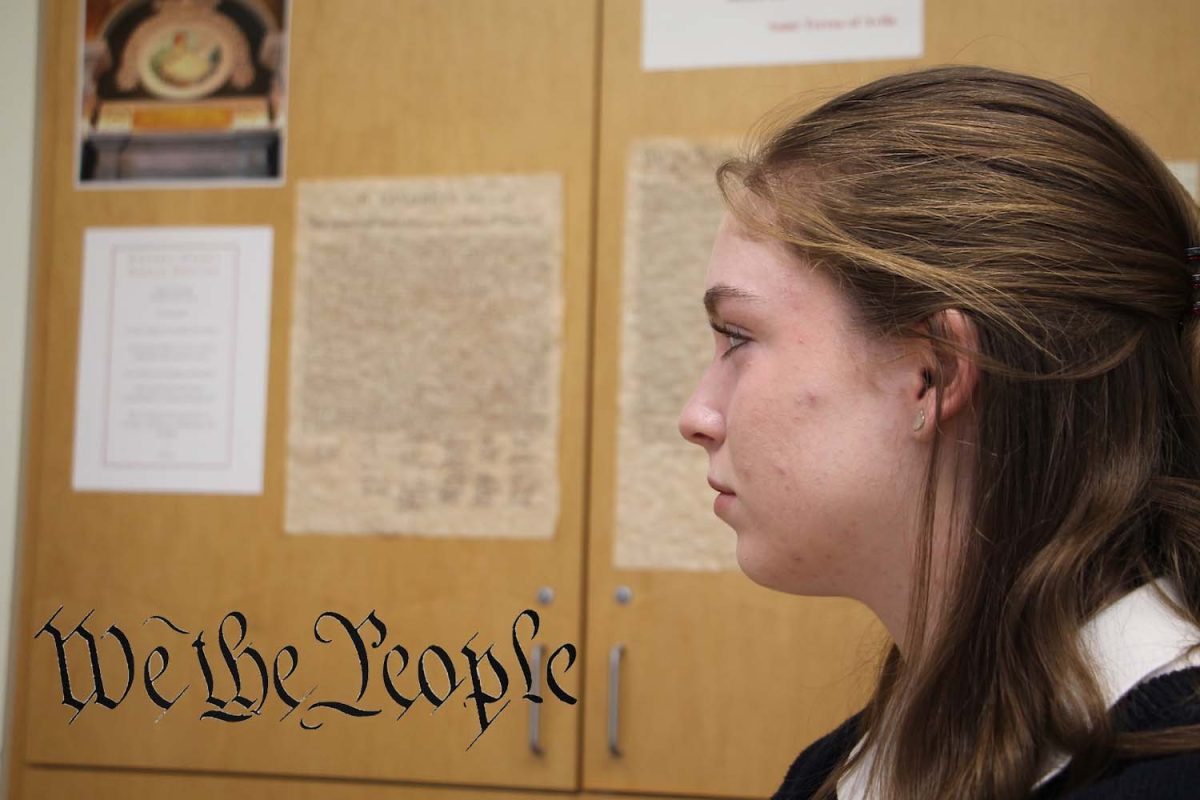Maine Law Enforcement found Mr. Robert Card, a 40-year-old firearms instructor, dead Friday, October 27, according to nbcnews.com. Officials suspected Mr. Card was responsible for the murder of 18 people two days earlier at two businesses, Schemengees Bar and bowling alley Sparetime Recreation, in Lewiston, Maine, according to nbcnews.com. The gunman injured up to 50 additional pedestrians, adding to over 560 instances of gun violence across the United States thus far this year, according to bbc.com. In response to this latest mass shooting, Mr. Vincent J. Badagliacca, Upper School History Teacher and History Department Chair, delineated the complex historical and political legacy of arms, and Mr. Wilford Smyers, Grounds Manager, and Mr. Richard Bernero, Chief Financial and Operations Officer, discussed their increased responsibility to protect Sacred Heart Greenwich students and faculty.
Pew Research Center, a nonpartisan think tank, estimated that gun deaths rose by 23 percent from 2019 to 2022, according to bbc.com. In response to the increase in firearm deaths, public health institutes such as the Center for Disease Control and Prevention (CDC) have begun to examine gun violence as an epidemic. Indeed, in 2021, there were 14.6 gun deaths per 100,000 people, the highest rate since the beginning of the 1990s, when the National Institute of Health (NIH) labeled the violence as an epidemic, according to npr.org.
Several politicians, including President Joseph R. Biden, have also adopted this label to call for increased legislative restrictions on firearm sales. Most recently, in response to the Lewiston shooting, President Biden urged lawmakers to protect the American people from assault weapons.

“While we have made progress on gun safety through the Bipartisan Safer Communities Act, […] it’s simply not enough,” President Biden said, according to wgme.com. “Work with us to pass a bill banning assault weapons and high-capacity magazines, to enact universal background checks, to require safe storage of guns, and end immunity from liability for gun manufacturers. This is the very least we owe every American who will now bear the scars – physical and mental – of this latest attack.”
Despite the conviction of some politicians, other organizations, such as the National Rifle Association (NRA), attest that guns do not increase crime but, rather, are a fundamental right of Americans under the Second Amendment. Even as firearm acquisitions and mass shootings have increased, the nation’s overall murder rate fell by approximately half from 1990 to 2016, according to brennancenter.org. The NRA argues that the government punishes “comparatively irrelevant” law-abiding gun owners and manufacturers instead of criminals, according to nraila.org.
Gun-rights activism arose prominently with the libertarian movement of the 1980s, in which citizens protested increased government imposition on their lives. In response, organizations such as the NRA and associated activists sought to secure increased protections for their firearms, according to michiganlawreview.org. After Washington, D.C. issued an all-out ban on handguns in the early 2000s, some Americans felt that this legislation stripped them of their Constitutional right to self-defense. This case ultimately culminated in the Supreme Court decision in District of Columbia v. Heller, which guaranteed private citizens the right to bear arms outside of connection to a militia under the Second Amendment for lawful purposes, according to supreme.justia.com.
Today, the right to bear arms is a contentious topic, with some arguing that the Heller decision expanded gun rights beyond the intent of the Second Amendment, according to michiganlawreview.org. As a result, federal, state, and local governments have had difficulty passing firearm control legislation.
After spending his early professional life as a lawyer, Mr. Badagliacca recognized the complex intersection between safety and freedom that arises due to gun control. He commented on the historical role of the Second Amendment. However, in a modern context, Mr. Badagliacca criticized the lack of nuance in the complex debate on gun violence. He noted that it is necessary to consider diverse perspectives when instituting firearm legislation. Despite conflicting viewpoints, Mr. Badagliacca stressed that meaningful change is possible if citizens can collaborate to protect their rights and the safety of others.
“Let’s figure out ways we can accommodate all the varying interests,” Mr. Badagliacca said. “On the ‘gun rights’ side, it’s an individual’s right to bear arms for personal or family safety against criminals […], or to permit legal hunting, or to protect a rural farmer and his livestock […]. On the ‘gun control’ side, there is a need to balance the rights of the individual with concerns of community or societal safety. So, we make laws and rules about the licensing and purchase of guns, and the types of guns available. These considerations have to be balanced. What is needed is thoughtful debate about the competing considerations of society in a very large and varied democratic republic. Not everyone’s going to be happy with this approach – there are those who advocate outright confiscation of all guns; while others oppose any kind of restrictions on guns. But, again, the rights of the individual for safety, protection […] need to be balanced with legitimate community and societal public safety interests.”

Uniformly across the country, gun violence has impacted American culture, particularly in American schools, over the past 20 years. Since the 1999 mass shooting at Columbine High School in Columbine, Colorado, more than 338,000 American students have experienced gun violence at school, according to sandyhookpromise.org. Indeed, guns have become the leading cause of death among American children and teens, with civilians age 19 or younger accounting for one in ten firearms deaths, according to sandyhookpromise.org.
Consequently, schools across the country, from daycares to colleges, have begun implementing safety procedures to protect students from potential mass shootings. Mr. Smyers and Mr. Bernero discussed their roles in establishing a secure and peaceful environment for Sacred Heart students and faculty. They emphasized the collaborative and continuous work of strengthening campus security.
“We’re always learning from [mass shootings],” Mr. Bernero said. “What are the tactics and techniques as to what works, and what doesn’t? Because you need to be able to train for all scenarios. […] Every time we do a drill, we ask all faculty and staff to provide input, on what worked, and what didn’t because we want to always make sure that we’re fixing issues. If there’s a door that doesn’t close, a blind that doesn’t close, questions they have, we view it as an open dialogue. […] As people ask questions, our job collectively is how do we answer those questions. We want every student to feel that we understand your issues, to give you that comfort, but also to make each other safer.”
Both Mr. Smyers and Mr. Bernero described their commitment to making Sacred Heart a safe and comfortable environment for all. Mr. Smyers reaffirmed that regular communication enables them to fulfill their responsibility for campus security.
“I think about [mass shootings] quite often,” Mr. Smyers said. “We all do. We have meetings at least once a week, sometimes more frequently, where we discuss issues like, Mr. Bernero said, we disseminate the information to make our security better. Bottom line is the most important thing is that every student here feels safe, feels informed, and is comfortable. It is unfortunate that [gun violence] has become more commonplace than what anyone would like.”
To combat school shootings, youth activism against mass shootings has risen in the past few years. Survivors of the 2018 Marjory Stoneman Douglas High School shooting in Parkland, Florida founded the organization March for Our Lives to advocate for firearm reform and turn out teen voters. This youth-run organization attempts to hold politicians accountable and eliminate the roots of gun violence, such as firearm glorification and mental illness, according to marchforourlives.com.
Four in five teens believe that gun violence is a problem in the US, and 47 percent of youth believe that increased firearm regulation will decrease the number of mass shootings, according to everytownsupportfund.org. Over 69 percent of Sacred Heart Upper School students who responded to a King Street Chronicle poll reported feeling scared after hearing news of a mass shooting. Over a third of students described feeling numb to the violence.

Students noted complex feelings about firearms, with 53 percent of respondents highlighting conflicted views about the rights guaranteed by the Second Amendment. The anonymous respondents stressed the complexity of maintaining defensive freedoms while reckoning with the consequences of gun violence.
“I think that the rights granted by the Second Amendment are too broad especially as it was written in a time when weapons were not nearly as powerful,” an unnamed student said. “I think the Second Amendment guarantees the rights to own guns that were made in the time it was written but the entire point of the Amendments to begin with was that there are differences over time and changes to be made that I think need to be made in this country because of the needs of our current situation, as we no longer live in the 18th century.”
Another anonymous respondent underscored her opposing sentiments in the debate on firearms. She grappled with the value of American lives and American freedoms.
“I support rights granted by the Constitution, but it also causes so much violence in our country,” the student said.
Upper School students also noted a stronger desire to regulate guns than the broader adult American population. 83 percent of students asserted that the government should more strictly monitor firearm sales as opposed to 58 percent of US adults, according to pewresearch.org. No student asserted that firearms regulations should definitely not be stricter.
Despite wide opposition, guns still hold recreational and emotional value for many bearers. For every 100 US residents, there are an estimated 120.5 firearms, the largest ratio in any nation, according to bbc.org. After the recent mass shooting in Lewiston, the town withdrew a scheduled prohibition on hunting before it could go into effect. Wildlife officials had previously coined October 28, the day after police found Mr. Card dead, as Maine Residents Only Day. This holiday is typically the most popular day for hunting statewide, according to nbcnews.com.
For some gun owners, the right to bear arms is central to their pride and freedom. Of the four in ten US adults who live in a firearm-owning household, 81 percent say they feel safer owning a gun, and 71 percent say they enjoy owning a gun. Only 12 percent of firearm owners say they worry about having a gun in the home, according to pewresearch.org.
Mr. Badagliacca emphasized the inherent complexity in the debate on gun violence but highlighted that he believes progress is possible. He noted the necessity of conversation and regulation to protect American lives and freedoms.
“It’s counterproductive to reaching agreement on a sensible accommodation regarding the issue when politicians, or when the extremes, resort to partisan demagoguery,” Mr. Badagliacca said. “In a large democratic republic, it’s not beyond our capability to agree, for example, that if you are properly licensed and own guns, you should be required to have them safely locked up; or that automatic assault weapons should not be available to a young man with a history of mental illness. Those types of common sense ideas are within our grasp as a society when we consider gun issues, gun control, and gun freedom.”
Featured Image by Lindsay Taylor ’24





Karl Haeseler • Nov 3, 2023 at 7:00 pm
Excellent article! I found it fascinating to learn about the various perspectives within our community regarding gun control. It may be worth noting the significant disparity in gun violence statistics between Europe and the United States. In Europe, where most constitutions don’t safeguard the right to own guns, mass shootings are relatively rare due to stringent gun access regulations.